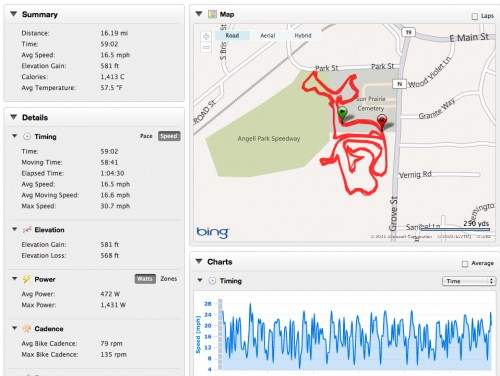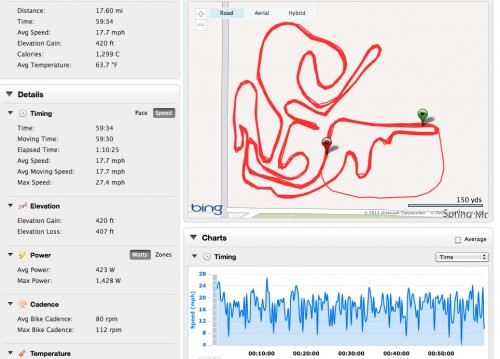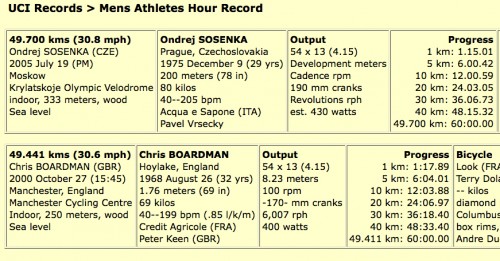I don’t have much more to say. If you had a chance to catch any of the USGP in Ft. Collins yesterday, you would have seen Ryan Trebon annihilate the best we have here in the United States. Jeremy Powers can obviously start about as fast as anyone in cross, but it didn’t take Trebon too long to catch up to him and then dispose of him. I was watching it on CyclingDirt.com. Click on the link if you want to watch today’s race live this afternoon. Race Results from yesterday.
Anyway, I was looking around and found the power downloads of Ryan’s power output at the Madison Cup race and Cross Vegas. I posted them below.( Here’s the link to Garmin.) I didn’t think it was humanly possible to be producing those numbers, especially in a cyclocross race. I have no idea what he is using for measuring his power, but something is amiss. Maybe he’s using a random number generator instead of a SRM? But, if the numbers from Madison are even close to correct, then he is focusing on the wrong aspect of this sport and should be winning classics and the like in Europe.
Below are some examples of high wattage output. “Experts” say you are a World Class rider if you can hold close to 6 watts per kilogram for 20 minutes. Ryan Trebon is a pretty big guy and he was doing nearly that for a full hour during a cyclo-x race. Like I said, if his average wattage in Madison of 472 watts is not just a made up number, then he is wearing the wrong jersey now and should be getting paid to race bikes by a Pro Tour Team.
Power from USGP in Madison (Click twice to enlarge.)

In 1975, Eddy Merckx did an hour ergometer test. Ed Burke reported he did an 455 watts average. That was pedaling continuously, not coasting around trees, etc.









The photos of his bike from Madison show that he was using a Quarq PM. I have two of them and they are pretty dependable units, so long as they are zeroed out in the same temperature/humidity conditions that the event was in. I have run into some inaccuracies with mine if I zero them at the start of a cold morning ride if the temps rise by more than 5-10 degrees. But usually for me, if the temps rise and I don’t re-zero, the power numbers drop below what they “should be”.
Certainly impressive numbers.
He’s using a Quarq. Very accurate meter
Meter isnt as important as how the “average” is being calculated. Garmin is notorious for their autostop, non zero calcs, and smart recording features not being in line with recording power the best.
That said, its most likely his non-zero power, or what everyone thinks of as normalized power. This can easily be higher if someone has good anaerobic capacity and in an event like cx, you would expect the normalized to be greater than the average due to the punchiness and time off the bike.
Hes still a beast.
definitely not calculating average power but rather pedaling power. i don’t know how much coasting you do in cross, but if it’s a lot the number can be really skewed.
he might not also have calibrated his quarq prior to race start, which could also lead to miscalculations.
Yeah, that’s an average number that doesn’t include zeros. Makes the numbers look elevated
Saw this file on another site. They actually talked to Trebon or someone in his camp…as others have stated, he is using a Quarq and collecting the data with “zeros excluded” on a Gamin Edge 500. The site went on to estimate that his actual power was around 396w with zeros included…fwiw.
Saw*
Steve,
The 6 watts/kg refernce for a world class rider is now close to 5.6 to 5.8 Watts/kg.
Remember Floyd Landis riding the TdF with a PowerTap and collecting data, which he did in the year Lance participated and won his seventh title. His rationale was that it will help him prepare for and win the next year TdF. Allen Lim was the guru who was helping him decipher the data. At that time the Watts/kg was way upwards of 6.0, more like 6.5, Academic analysis from that time, that was based on the VAM calculation that Ferrari had incorporated, placed it close to 7.0 W/kg.
That number has steadily declined ever since. Last year at the TdF it was about 6.0 to 6.2 and this year it was down to 5.8 to 6.0.
Nowadays riders power data is available and shared on wedbsites like SRM, Training Peaks etc. People like Hunter Allen, Andrew Coggan and Ross Tucker & Jonathon Dugan of The Science of Sports project have done considerable analysis of power files from riders that participate in Grand Tours, week to 10 day stage races and classics. All that analysis is a Google search away for anyone who is curious.
They are constantly redifining the watts/kg number that a rider has to be capable of generating to be a contender in the TdF. The literature that I have come across does not define W/kg number over a 20 min period and the 6.0 W/kg you are refering to is on a sustained climb and not in the flats.
Also bear in mind that the true accuracy of a power meter is in the slope calculation which is done at calibration. If a rider or team does not want to share the real data but are obligated by the sponsor to do so, then all they have to do is change the slope programmed in the powermeter before the race and then revert back to the actual number after the race.
The zero offset is for the internal calculation of where the X axis will be. The power meter is really measuring the torque and calculating the power based on the equation Pwr = trq * rpm. So take these power numbers with a grain of salt. It is not apples to apples comparison.